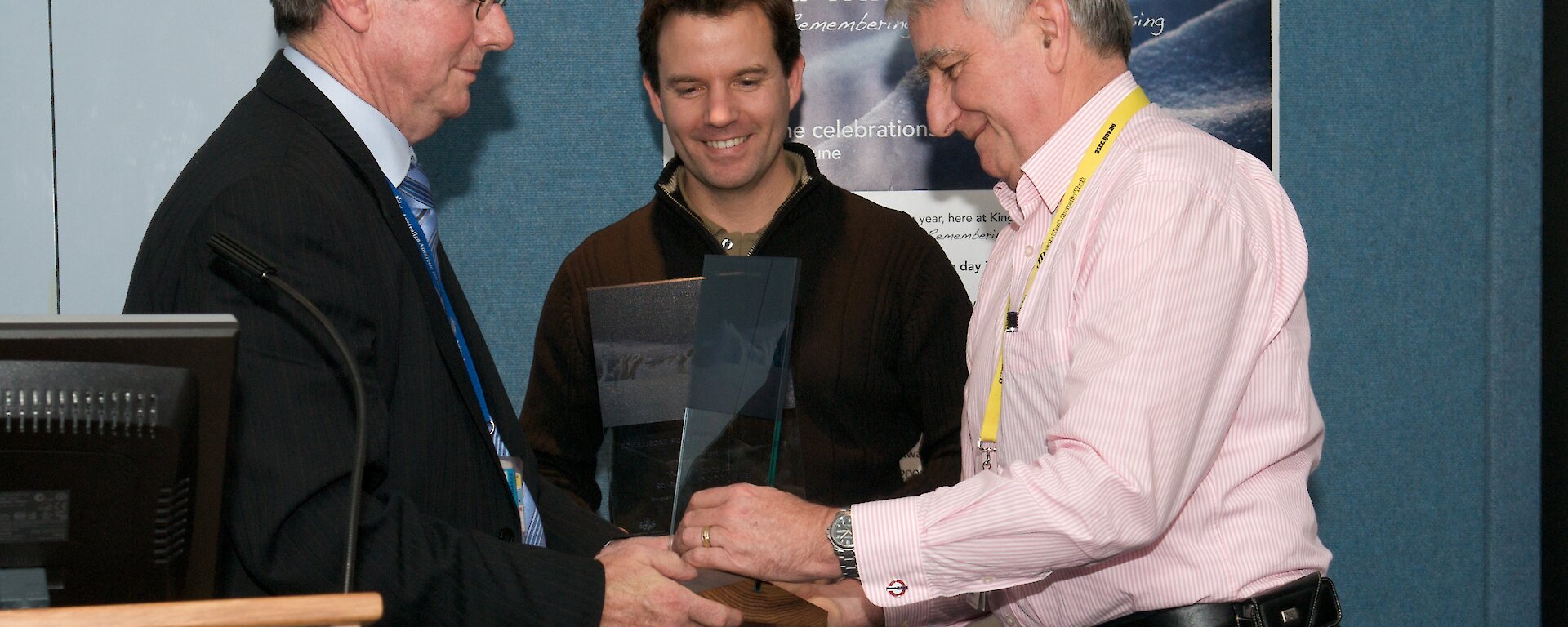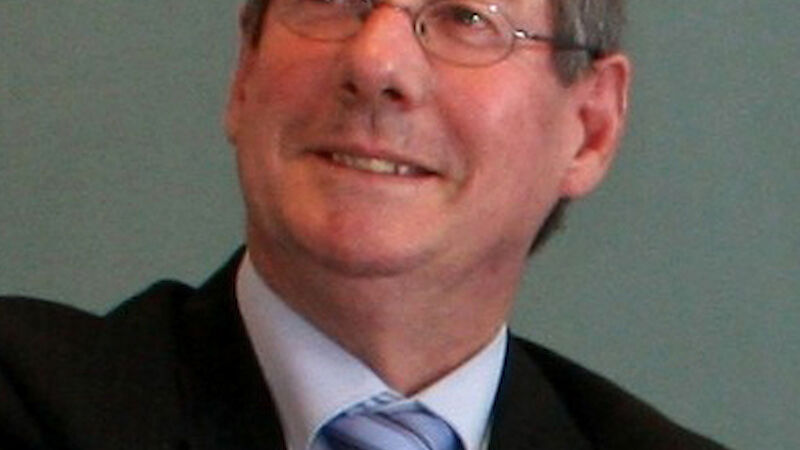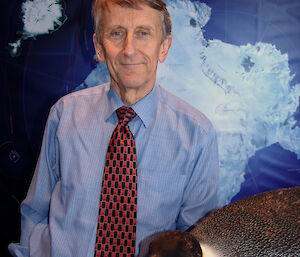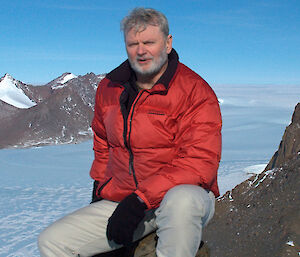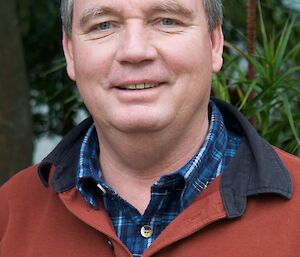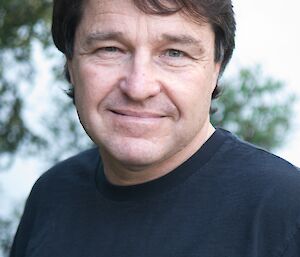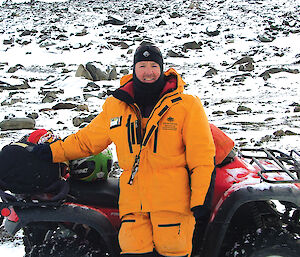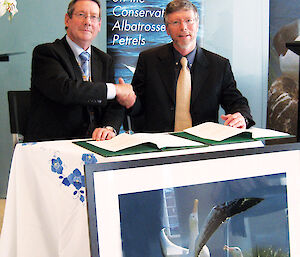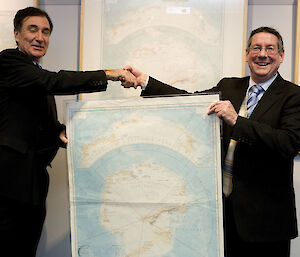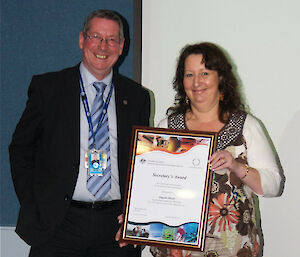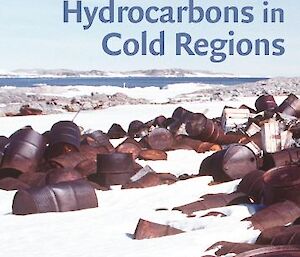Director joins the ACE CRC
After 10 years as Director of the Australian Antarctic Division, Dr Tony Press is leaving to take up the Chief Executive Officer position at the Antarctic Climate and Ecosystems Cooperative Research Centre (ACE CRC) in early 2009. Dr Press has had a long career in science, natural resource management, public administration and international policy.
The ACE CRC is a collaboration between core partners — the Australian Antarctic Division, CSIRO Marine and Atmospheric Research, the University of Tasmania and the Bureau of Meteorology — and a consortium of other partners. The Australian Antarctic Division wishes Dr Press all the best in his new role.
Antarctic Chief Scientist moving on
After a decade of guiding Australia’s science program in Antarctica, Chief Scientist Michael Stoddart, is also leaving the Australian Antarctic Division.
Professor Stoddart joined the Division in 1998 after an impressive academic career in Scotland and the United Kingdom, and his appointment as Professor of Zoology at the University of Tasmania in 1985, and Deputy Vice-Chancellor at the University of New England in 1993.
His arrival at the Antarctic Division coincided with a push for an air link between Hobart and Antarctica. In 2004 he played a central role in a presentation to government of Antarctic science and the importance of an air capability.
Professor Stoddart has been a driving force behind Australia’s coordinating role in the Census of Antarctic Marine Life — an International Polar Year project. Professor Stoddart will continue his work with the Census of Antarctic Marine Life until 2010 and his connection with the Antarctic programs of Malaysia and France.
Station Leaders for 2008–09
Antarctic and Macquarie Island stations leaders for 2008–09 are:
CASEY — Graham Cook
Graham returns to Antarctica after spending 2007 as the Davis Station Leader and 2005 as the Mawson Station Leader. Prior to that he spent three years in a dual role as Operations Manager with Federal Hotels’ Strahan Village Resort, and Manager of Gordon River Cruises on Tasmania’s west coast. Between 1991 and 2001 he was responsible for the operation of a number of remote Aboriginal community stores and Aboriginal enterprise developments in Arnhem Land in the Northern Territory, the Kimberley in Western Australia, the Tanami and Great Sandy Desert areas, and the northern Gold Fields of Western Australia. Graham has travelled extensively throughout South East Asia. He is a keen mountaineer, skier and bushwalker.
DAVIS — Bill De Bruyn
Bill is a Divisional Superintendent with Victoria Police. Since joining the Victoria Police Force in 1972, at the age of 18, he has performed duties in all facets of policing, including task forces and crime squads. He has also been in charge of country and metropolitan police stations and major events such as the Australian Motorcycle Grand Prix at Phillip Island. He has won several national and state crime prevention awards. He and his wife Christine have two adult children — his daughter is a police woman and his son an electrical linesman. Bill is actively involved in his local football club and enjoys most outdoor sports.
MAWSON — Peter Hackworth
Before joining the Antarctic Division Peter was the CEO of the Phylloxera and Grape Industry Board in South Australia. His favourite wine is currently Yalumba’s ‘Mawson'; a blend of cabernet, shiraz and merlot. Yalumba was a sponsor of Douglas Mawson’s 1911–14 expedition and this wine was named in recognition of his achievements. Peter’s other link to Mawson is his grandfather, who was a young crew member on the Aurora during its 1912 voyage to retrieve Mawson. Peter is a keen bushwalker, canoeist and cyclist. After pedalling around Europe, he and his partner Rosie established a cycling hire and touring business which they ran for a decade from the mid-80s. Peter has also worked with disadvantaged youth in an outdoor education capacity; in regional economic development in Victoria and South Australia; and for the Australian Competition and Consumer Commission.
MACQUARIE ISLAND — Jason Ahrens
Jason will perform the combined role of Station Leader and Building Services Supervisor at Macquarie Island. He was previously employed at Davis as the wintering Building Services Supervisor, senior plumber and Deputy Station Leader (Australian Antarctic Magazine 12: 36, 2007). Jason has extensive experience in the plumbing industry and in staff and contractor management. He has been a member of the Country Fire Authority in Victoria for 13 years.
Director’s Awards 2008
During mid-winter celebrations this year Australian Antarctic Division Director, Tony Press, presented Director’s Awards to:
- the Casey and Wilkins summer crew of 2007–08, for exemplary service in support of the inaugural season of the Antarctic Air Link;
- Aaron Spur, for exceptional service, leadership, teamwork and commitment in support of the Australian Antarctic program’s (AAp) marine science activities;
- Robb Clifton, for exemplary personal leadership in the planning, support and conduct of operations during the AAp’s 2007–08 summer season; and
- the Corporate Services Group, for consistently providing a high standard of administrative support to the AAp.
Australia formalised as home of international Seabird Secretariat
Hobart, Tasmania, became the official home to the Secretariat for the Agreement on the Conservation of Albatrosses and Petrels (ACAP) in June.
The historic Headquarters Agreement for the Conservation of Albatrosses and Petrels is the culmination of negotiations between the Australian Government and other Parties to ACAP, to establish the Secretariat in Hobart, which has been the interim host in recent years.
Tasmania has a strong and long-standing commitment as a host to international Secretariats and organisations with an Antarctic or Southern Ocean focus, including the Commission for the Conservation of Antarctic Marine Living Resources, the Council of Managers of National Antarctic Programs, and the French Polar Institute’s southern base.
Historic map preserved in National Archives
The Australian Antarctic Division has presented the National Archives of Australia with the first Australian map of the whole Antarctic continent, published in 1939.
'We decided this map belongs with the National Archives, which has the conservation expertise to ensure its preservation for future generations of Australians,' Australian Antarctic Division Director, Dr Tony Press, said.
National Archives Director-General Ross Gibbs said the map was an important part of Australia’s history in the Antarctic and would provide a valuable resource for historians, scientists and researchers. The National Archives’ brief is to preserve Commonwealth Government documents and ensure the public has access to them.
The handover of the map, originally produced by the Department of the Interior with an accompanying handbook, coincided with the 75th anniversary of the transfer of the Australian Antarctic Territory from Great Britain to Australia in 1933. In 1939 the map, which charts the claim, was created using details provided by pioneering expeditions and early flights over the southern continent.
New Mawson’s Huts Management Plan and web site
The Mawson’s Huts Historic Site Management Plan 2007–2012, launched in June, sets out the direction of management of huts built and occupied by Douglas Mawson and his men during the 1911–1914 Australasian Antarctic Expedition. The site is regarded as Australia’s most significant historic presence in Antarctica.
At the launch of the plan in Canberra, Environment Minister, Mr Peter Garrett, said it would ensure the proper care and conservation of the place Douglas Mawson called ‘the home of the blizzard'. A number of expeditions by the Australian Antarctic Division and the Mawson’s Huts Foundation have carried out a range of critical conservation work in recent years, and this work will continue. View the management plan and the new Mawson’s Huts web site.
Secretary’s Awards
Many deserving Australian Antarctic Division staff received Departmental Secretary’s Awards this year, in three categories. Atmospheric scientist, Gary Burns, was recognized for ‘effective mentoring and role modeling'; the Business Support Team and analytical chemist, Greg Hince, were recognized for ‘knowledge sharing within teams'; and Angela Doyle of the Polar Medicine Unit, was recognised for her ‘consistent contribution to the Department’s goals'.
Bioremediation in cold regions
Contaminants Geochemist, Dr Ian Snape, of the Australian Antarctic Division, has co-edited a practical guide to bioremediation in cold regions. The book, Bioremediation of Petroleum Hydrocarbons in Cold Regions, is targeted at environmental practitioners, industry and regulators, and was written by environmental engineers and scientists with first-hand experience of bioremediation in polar regions. The book contains in-depth discussions on regulations, identification and adaptations of cold-tolerant bacteria, contaminant transport in cold soils and permafrost, analytical methods, treatment, emerging technologies…and much more. Dr Snape and his colleagues in the Environmental Protection and Change program at the Antarctic Division have authored several chapters. The book is available from Cambridge University Press Australia for $199.
Magazine survey
Earlier this year a survey was conducted amongst Antarctic Division staff to find out what they like, or would like, to read in this magazine. A range of inspiring ideas were collected, some of which appear in this issue. Among these are an overview of the science season ahead, and more historical articles and profiles of expeditioners and/or head office staff. Interest was also expressed in international events and science programs, life on station, technology used in Antarctica, and operating aircraft in Antarctica. These and other ideas will continue to be integrated into future issues of the magazine. The Editor thanks participants for their ideas and suggestions.

